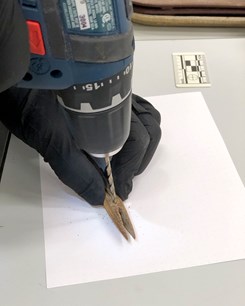February 28, 2023
by Scott Shirar and Josh Reuther

Radiocarbon is a common dating technique in archaeology and is used to estimate the age of archaeological sites and objects. The principles behind radiocarbon dating are based in chemistry and physics; the technique was widely developed by chemist Willard Libby and his colleagues in the 1940s. Radiocarbon dating is based on the fact that all living things are largely made up of carbon, which is continually present in the atmosphere, absorbed by plants through photosynthesis, and incorporated into the tissues and inorganic minerals of plant- and meat-eating animals. Radiocarbon dating only works because there is a constant presence of unstable (radiocarbon) and stable carbon isotopes in the world, and all living organisms have absorbed these carbon isotopes in some way. Once an organism dies, the radiocarbon (unstable carbon isotope) begins to dissipate, or decay, at a known rate.
Archaeologists can tell how old a piece of wood or charcoal is, or a piece of antler or animal bone found at an archaeological site by measuring the amount of radiocarbon remaining in a sample. Measuring the radiocarbon content requires specialized equipment, which means that archaeologists choose the items they want to date and send them off to one of several labs across the country. These radiocarbon labs take the radiocarbon measurements and report the results back to us. The longer something has been dead and buried under ground, the less radiocarbon is retained as it decays, and eventually is gone over 70,000 years since the organism’s death. In Alaska, the oldest known archaeological site is about 14,500 years old, which makes radiocarbon dating a viable option for any archaeological site in the state.
Here's a great, in-depth and illustrated explanation of radiocarbon dating.

Photo 1: Drilling a slotted antler projectile point for dating

Photo 2: Shavings from slotted antler projectile point to be submitted for dating (left) and charcoal (right) about to be prepped and sent to the radiocarbon lab.
Radiocarbon dating is an important and essential technique for the Aleutian Mercury Dynamics project because it is how we associate a specific archaeological sea lion, fur seal, or cod bone with a point in time. For many of the bones that are chosen for mercury analysis, we rely on radiocarbon dates that were run in the past from previous research projects. This is a great example of how past research contributes to modern studies and how science builds over time. Data generated from past, completely unrelated projects is often what makes many new projects possible. In our case, a single radiocarbon date costs between $400 and $600, so running 100 new dates is very costly. In addition to monetary cost, the time to comb through field notebooks, reports, and museum collections to choose appropriate samples for radiocarbon dating could take months or years. Simply put, our project would not be possible without radiocarbon dating techniques and without previous archaeological research that has taken place in the Aleutian Islands.